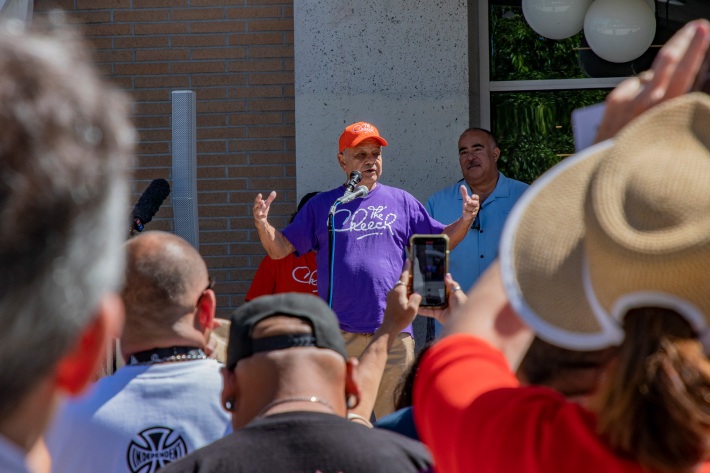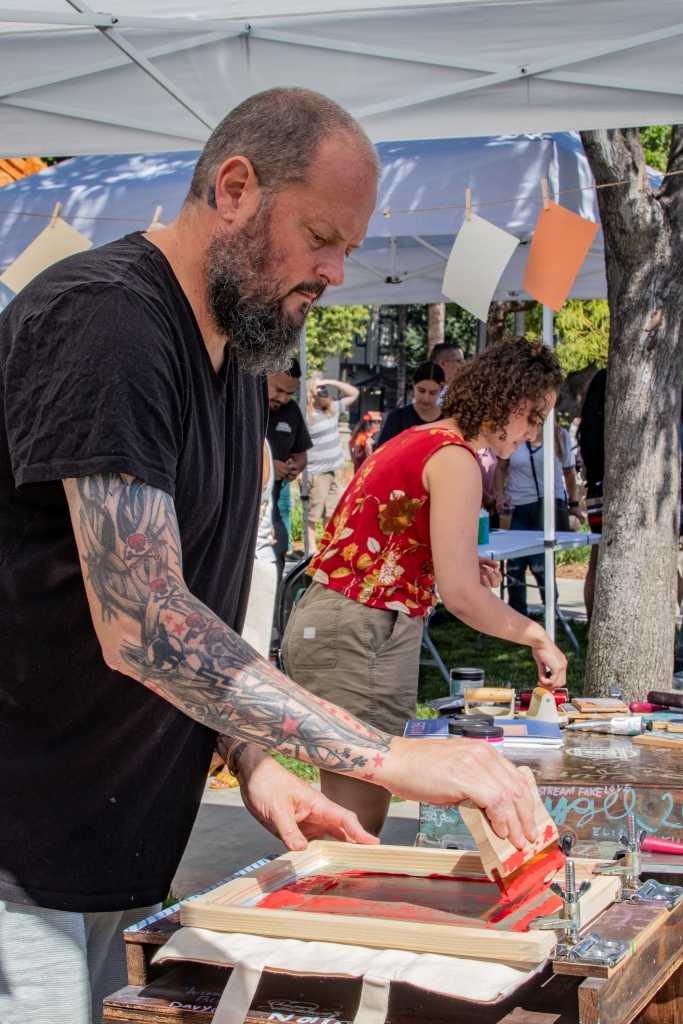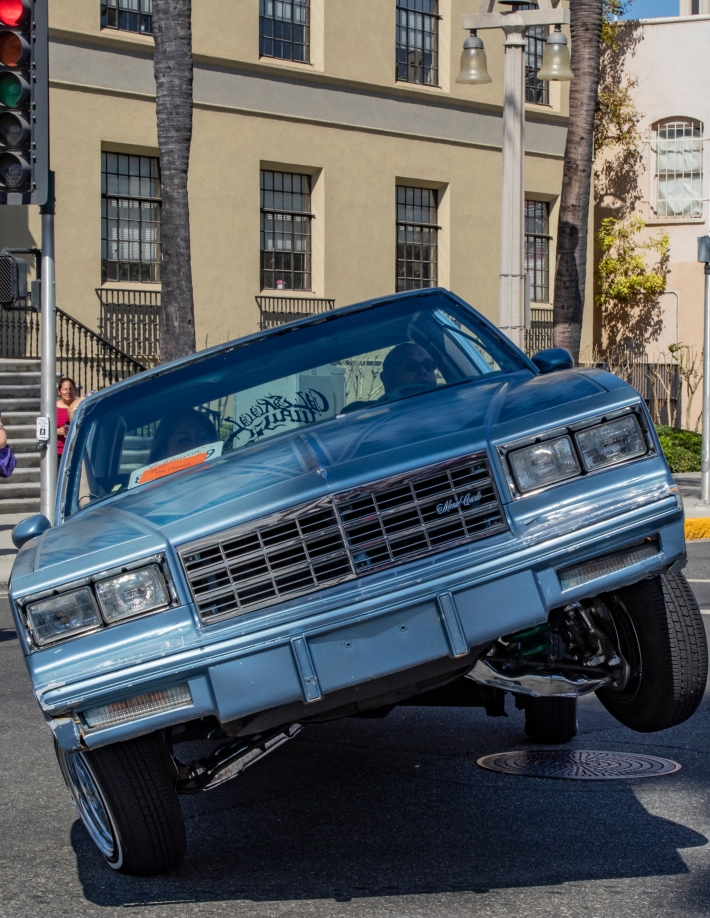Mail Model
A prompt to encourage your practice of creativity this week from Riversider and local author Larry Burns.
On Saturday, Cheech Marin opened the museum that bears his name, inviting the community to enjoy his collection.

A swirl of colors and sounds and people dominated the plaza at 3581 Mission Inn Avenue – the metallic flake paint of the low-riders, the embroidered Technicolor dresses of the dancers, the oldies played over the loudspeakers, and the people gathered around artists’ booths for a glimpse of their latest work – all coming together at the opening of the Cheech Marin Center for Chicano Art and History on Saturday.
Standing on the steps of the building remade and filled with the art he loves, Cheech Marin spoke to the crowd. “This is a dream I never dared dream.”
Just five years after its inception, an unheard-of timeframe in the museum world, The Cheech is now a permanent home for Chicano art, possibly the only one like it in the country. Riverside Mayor Patricia Lock Dawson put it succinctly: “Today we open The Cheech and show the world how it’s done.”

At one point, the sound of conch shell horns and trumpets cut through the buzz of excitement on the plaza. On the patio near the entrance, Aztec dancers wearing elaborate headdresses and costumes in magenta, sunshine yellow, and turquoise began performing to a drum’s beat, the shells and wooden beads on their leg coverings swishing as they moved.
“I’m so proud of our city!” said Rachel Porter, who lives in downtown Riverside. A 2016 transplant from Boston by way of Portland, Oregon, two cities known for their vibrant arts scenes, Porter said she’d had no qualms about relocating to Riverside when her husband accepted a teaching position at UCR. She’d liked what she saw of Riverside at the time, especially the award-winning neighborhood school her young daughter would attend, and over the years, projects like the new library and the Cheech have cemented her good opinion of the city.
She thinks her transplant status may have given her a different perspective. ”I think it’s easy not to notice something when it’s growing in front of you,” said Porter. “When you live in a place, you don’t always see it. People are just overwhelmed by having something like this in their city.”
As usual, at an event like this food vendors were thick on the ground, selling different flavors of Micheladas (a popular item at $15 each), lemonade ($7) and tacos (priceless) plus the usual kettle corn and hot dogs.
One of the most popular booths wasn’t selling food but offered another form of nourishment — free art prints and silk-screened tote bags made on the spot by Matt Luther, professor and faculty advisor for the Riverside City College Print Making Shop, and students Anthony Ortega and Jillian McCombs.

“It’s important – making art accessible and getting art beyond the studio and out to the community,” said Luther. “Printmaking has always been a way to do that. It’s an easy way to get things out to the masses.”
Next door to the printmakers, artist John Cuevas stood inside his booth with the beginnings of a landscape mural painted in the colors of a sunset, with soft corals and yellows with hints of orange. Cuevas invited people to write the name of a lost loved one on the mural, thereby making them a part of the piece. He hopes to see the finished product installed in the community gallery in February 2023. “When (you) go to The Getty, you see a lot of colonial history — you see who gets memorialized and who doesn’t. (The Cheech) is the perfect way to be, Hispanic representation treated with as much dignity as we’ve seen with other cultures.”
Rene Camargo, president of the Ride n Pride car club, whose members formed a multi-vehicle low rider procession to deliver Cheech to the opening, was part of a committee created five years ago to support the museum. He said he loves the way Hispanic culture is represented by the Cheech, and sees it as a place for his children to learn more about their culture, art, music and history.

Watching the development of the Cheech has been inspiring artists throughout the Inland Empire for years.
Perris painter Michael Kim, 47, whose piece, “Broken Warrior“ is featured near the entrance of the museum, said getting a piece in the Cheech was one of his goals.“My intention is to show the positivity of it, and the beauty of our culture,” said Kim.

The general consensus held that The Cheech is a win-win-win–for artists, for the community and for the city itself.
“I think it reinforces our dedication to art and culture, and it makes it a destination for the city all across Southern California,” said David Revolo. “It’s beneficial to Riverside….our kids are also Hispanic and it’s important we show them their culture.”
California State Assemblymember Sabrina Cervantes, who represents the 60th Assembly District, said the opening of the Cheech “is truly a transformative experience. We’re able to bring together a diverse group of people all across Riverside and beyond to celebrate Chicano culture.”
“Growing up Mexican American I rarely saw my culture be displayed, especially in the form of art,” Cervantes continued. “Having this beautiful museum in our local community dedicated to cultural art is historic, not just for California but for our country.”
Chicano art and culture now have their own place in Riverside, and as Marin stated in his speech, “This is your home.”
The crowd burst into applause, and the dancing and the music and the colors started swirling again.
Reporters Alan Baez, Elmer Mejia Sagastume, Julia Goodman and Hayden Kulick contributed to this story.
Let us email you Riverside's news and events every Sunday, Monday, Wednesday, and Friday morning. For free